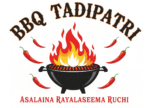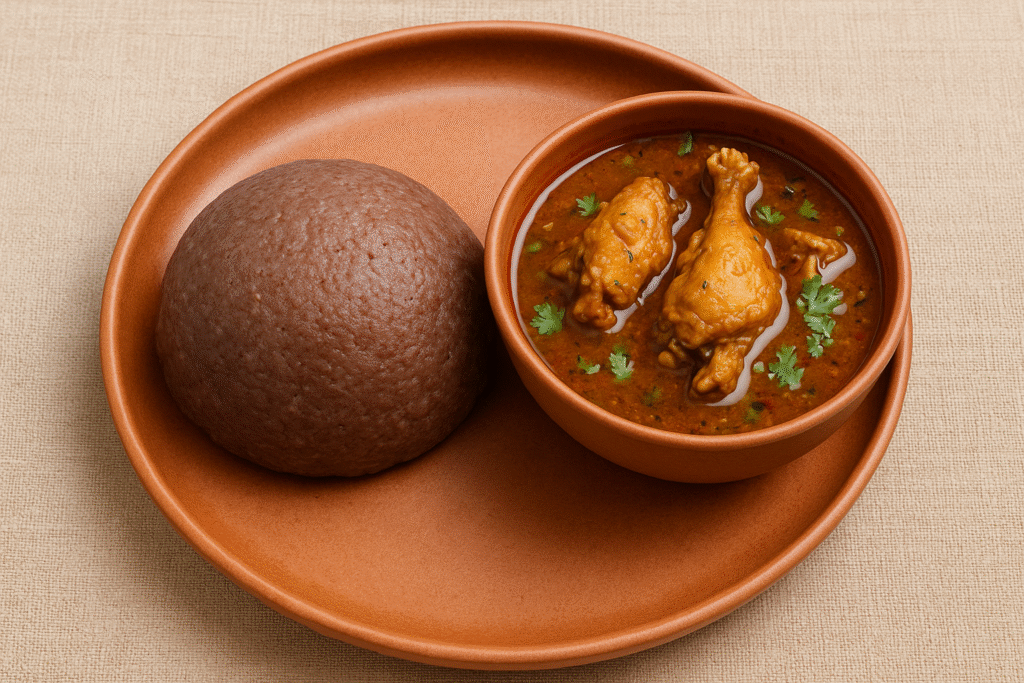Table of Contents
- The Soul of Rayalaseema Food
- Signature Combos & Meaty Classics
- Everyday Staples & Breads
- Breakfast & Tiffins You Shouldn’t Miss
- Vegetarian Favorites with Big Flavor
- Pickles, Podis & Chutneys (Turn Up the Heat)
- Sweets & Festive Treats
- Cooling Drinks & Simple Sides
- Order Like a Local (Pro Tips)
- Where to Eat: City-by-City Pointers
- Pantry Essentials for Cooking at Home
- Quick Home-Style Mini-Recipes
- Sample One-Day Food Trail
- Comparison Table: What to Try First
- Final Thoughts & How to Use This Guide
Rayalaseema Food: What Makes It Special
If you’re new to Rayalaseema food, start with ragi sangati because it is bold, rustic, and honest. It celebrates millets like ragi (finger millet) and jowar (sorghum). It leans on groundnut (peanut) for body and richness. It loves red chillies, but not heat for heat’s sake—chilli is balanced with tamarind tang, gongura (sorrel), onion sweetness, and the deep savor that comes from slow cooking.
Three things define the plate:
- Hearty bases — ragi sangati (steamed ragi balls), jonna rotte (sorghum flatbreads), or hot rice.
- Fiery yet balanced gravies — chicken, mutton, fish, or vegetable curries with a clear tang and spice.
- Powerful sides — peanut chutney, sesame podi, gongura pachadi, and sunny pickles that wake up the palate.
Technique matters. Meats often simmer low and slow. Tempering with mustard, garlic, curry leaves, and crushed chillies builds aroma. Clay-pot cooking adds smoke. The result is food that’s comforting and intense at the same time.
Signature Rayalaseema Food Combos & Meaty Classics
Ragi Sangati (Ragi Mudda) + Natu Kodi Pulusu
If you eat one meal in Rayalaseema, make it this. Ragi sangati is steamed, hand-shaped ragi and rice—warm, nutty, and filling. It’s paired with natu kodi pulusu, a country-chicken gravy built on onions, chilli, and tamarind. Tear a piece of sangati with wet fingers, press a little well in it, let the gravy pool, and taste. You’ll understand the region in one bite: earthy, tangy, fiery, and deeply satisfying.
Why it’s special: ragi’s gentle bitterness softens the spice; chicken’s collagen and bones add body to the sauce; tamarind keeps every mouthful bright.
Gongura Mutton
Gongura (sorrel) adds a lemony, leafy tartness that makes mutton feel lighter and more aromatic. The gravy looks dark and dense, but the flavor pops—sour, spicy, meaty. Scoop it up with jonna rotte or mix with hot rice and ghee.
Seema Mutton Fry
A dry, aggressively spiced mutton fry with curry leaves, garlic, and black pepper. The meat stays juicy; the edges crisp. It’s a perfect side with rotte and a cold buttermilk.
Kodi Vepudu / Kodi Kura
Two classic chicken formats: vepudu (dry fry) with crunchy edges and kura (gravy) with a bold, onion-forward base. Both ride on crushed chilli, coriander, and a fragrant tempering.
Chepala Pulusu (Fish Curry)
A tamarind-rich, chilli-bright fish curry. Even away from the coast, homes love it. The magic is in the balance—sourness that lifts the warmth of the spices without drowning the fish.
Kunda-Style Chicken (Clay-Pot)
Slow-cooked in a kunda (clay pot) for a subtle smokiness. The gravy clings to the chicken, the aromatics melt, and the heat feels round and cozy.
Everyday Staples & Breads
Jonna Rotte (Sorghum Roti)
Gluten-free, nutty flatbreads that pair beautifully with spicy curries and podis. Rotte has a gentle chew and a toasty aroma from the griddle—amazing with ghee and a sprinkle of sesame podi.
Sajja Rotte (Pearl Millet Roti)
Another millet mainstay—mild, rustic, and filling. Great with vegetable curries and pickles.
Annam + Pappu / Pappu Pulusu
Hot rice with pappu (dal) or pappu pulusu (a thin, tangy dal-based stew) is comfort on hot days. Have it with ghee, a piece of pickle, and a handful of fried papads or vadalu.
Podi & Chutney on the Table
Peanut (palli) chutney, karam podi (fiery chilli-garlic powder), and nuvvula podi (sesame powder) live on many tables, ready to transform plain rice or rotte in seconds.
Breakfast & Tiffins in Rayalaseema Food Culture
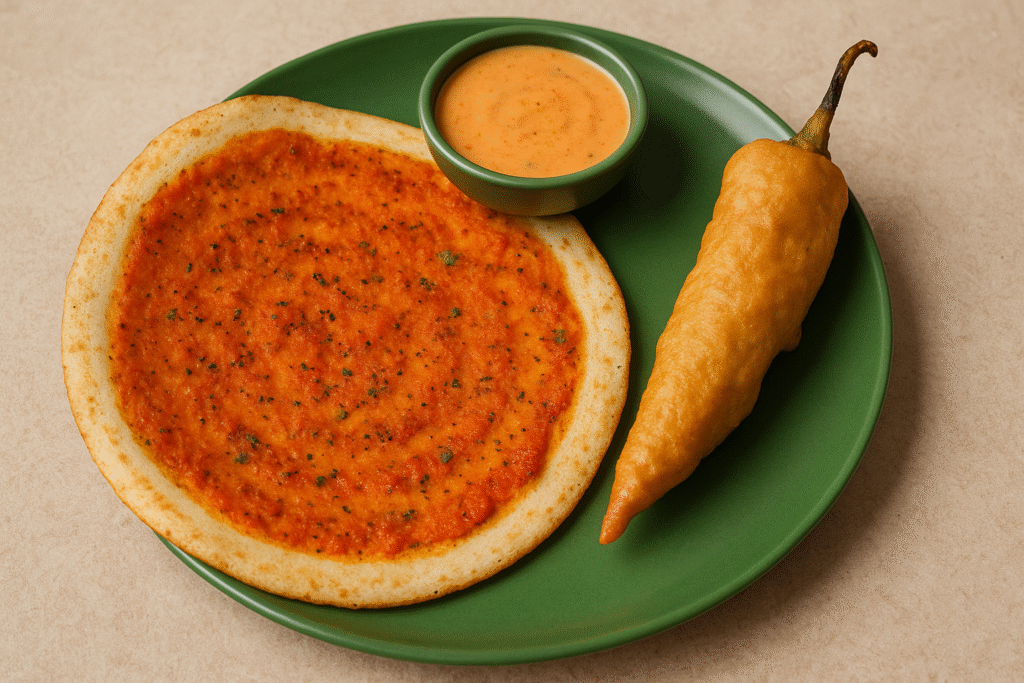
Karam Dosa (Tirupati-Style)
A crisp dosa spread with a red karam paste (chilli-garlic-spice), sprinkled with onions and sometimes upma. It’s crunchy, spicy, and shockingly addictive. If you love heat at breakfast, this is it.
Uggani with Mirapakaya Bajji
Uggani is a puffed rice upma—light, lemony, and spiced. It’s served with mirapakaya bajji, big green chilli fritters that are hot but mellowed by the batter. Bite chilli, then spoon uggani. Repeat. Thank us later.
Garelu (Vada) with Gravy
Crisp, golden garelu (urad dal vadas) are a tiffin staple. Pair them with sambar, palli chutney, or—if you spot it—natukodi gravy for a next-level combo.
Idli with Palli Chutney
Soft idlis, roasted peanut chutney, a drizzle of ghee. Simple, but the peanut makes it deeply Rayalaseema.
Vegetarian Rayalaseema Food Favorites
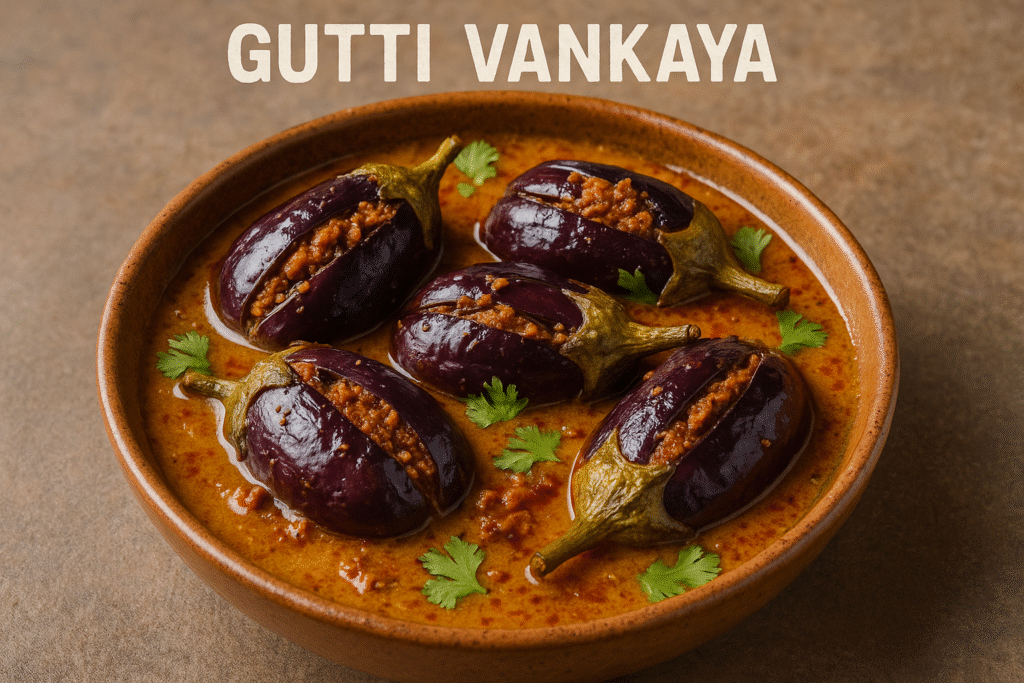
Gutti Vankaya Kura
Baby brinjals stuffed with a roasted peanut-sesame-spice paste, simmered to silky perfection. The sauce is nutty, spicy, and slightly sweet from onions. A must-try with jonna rotte.
Nune Vankaya
“Oil brinjal” sounds heavy, but done right it’s luscious, smoky, and jammy. Brinjal absorbs aromatics and becomes spoonable—great with plain rice and ghee.
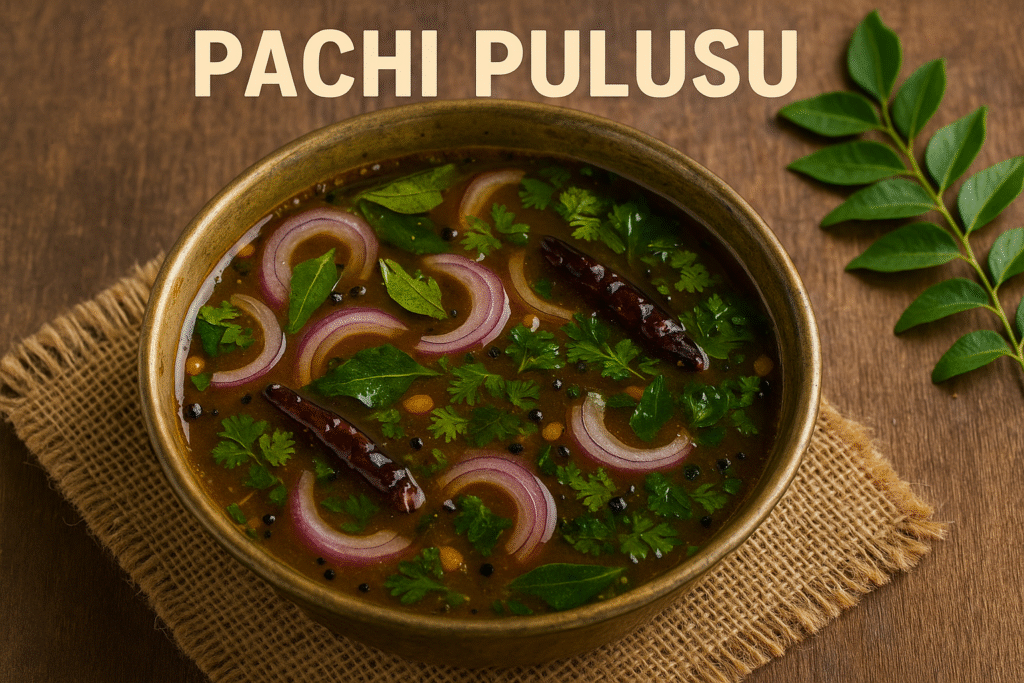
Pachi Pulusu
A raw-style tamarind rasam that’s quick, cooling, and punchy. Thin, tangy, dotted with onions and green chillies. Perfect in summer or alongside rich fries.
Seasonal Greens and Simple Fries
You’ll often see thotakura (amaranth) stir-fries, bendakaya (okra) fries, and dondakaya (ivy gourd) sautés. Crisp edges, soft centers, a little chilli, and curry leaves—weekday heroes.
Pickles & Podis in Rayalaseema Food
Gongura Pachadi
The crown jewel of the condiment plate. Sour, spicy, and aromatic. Mix it with hot rice and ghee or swipe it onto rotte between bites of mutton fry.
Avakaya (Mango Pickle), Tomato Pachadi, Lemon Pickle
Familiar to many across Andhra, but the Rayalaseema versions lean confidently into heat and garlic. Even a teaspoon wakes up a meal.
Palli Chutney & Nuvvula Podi
Peanut chutney adds protein and butteriness; sesame podi brings nutty depth. Both round off the chilli punch without dulling it.
Sweets & Festive Treats
Ariselu (Adhirasam)
Rice flour and jaggery pressed and fried to a glossy, chewy disc, then kissed with ghee. Crunchy edges, soft centers—festival nostalgia in a bite.
Sunnundalu
Urad dal laddus bound with ghee and jaggery. Rich, protein-packed, and not overly sweet. One with tea is perfect.
Madatha Kaja (Tirupati)
A layered, syrup-soaked sweet that flakes like pastry. The outside snaps; the inside drinks syrup. Lovely after a salty, spicy meal.
Tirupati Laddu (Prasadam)
Iconic for a reason. A unique texture and aroma that every visitor remembers.
Cooling Drinks & Simple Sides
- Majjiga (Buttermilk): Whisked with salt, ginger, green chillies, and curry leaves. Calms the palate between spicy courses.
- Ragi Malt (Sweet or Savory): A nourishing ragi drink—cooling in summer, comforting anytime.
- Cucumber & Onion Salads: Quick, crunchy, and refreshing with lemon and salt.
Order Like a Local (Pro Tips)
- New to the heat? Ask for “medium spice” first.
- Pair gravies with ragi sangati or jonna rotte—millets balance chilli better than plain rice.
- Add ghee strategically; it softens spice and carries aroma.
- Treat peanut chutney like a sauce, not just a side.
- For breakfast, karam dosa + mirapakaya bajji is a rite of passage.
- Don’t rush. Many dishes—especially mutton and clay-pot curries—shine when savored.
Where to Eat Authentic Rayalaseema Food
You’ll find authentic flavors in military hotels, roadside messes, and home-style eateries.
- Kurnool & Anantapur: Look for old-school messes serving ragi sangati, natu kodi pulusu, seema mutton fry.
- Kadapa: Homestyle lunch spots excel in gongura mutton, gutti vankaya, pachi pulusu.
- Tirupati (Chittoor): Bustling tiffin centers for karam dosa, uggani-bajji, garelu, and classic sweets.
(Names change often—ask locals or browse current reviews when you’re in town.)
Pantry Essentials for Cooking at Home
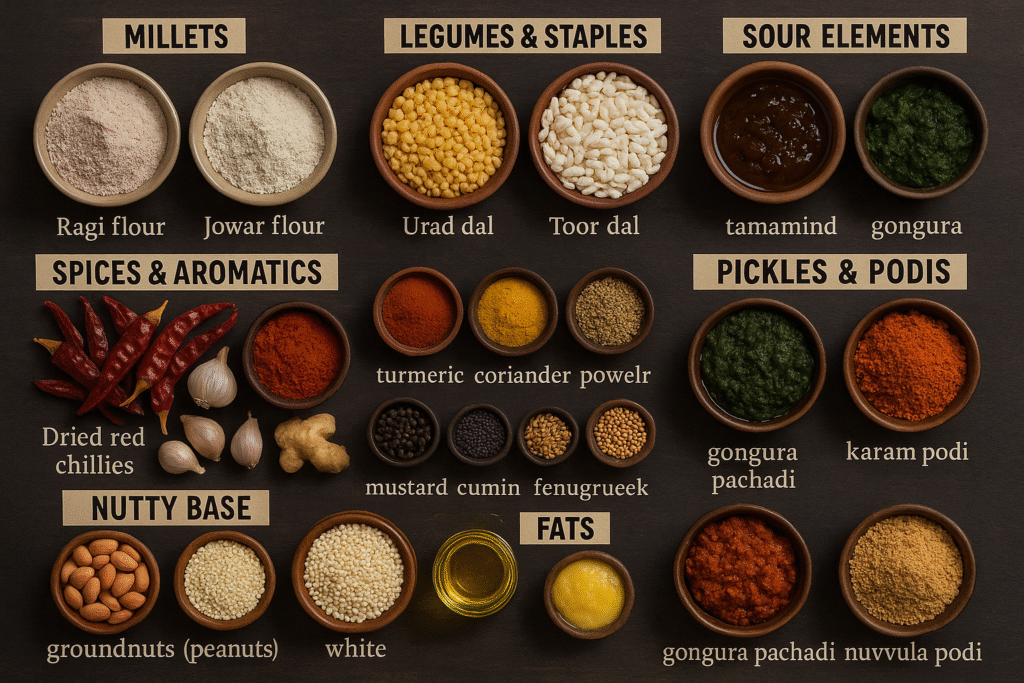
Stock these and you’re halfway to a Rayalaseema kitchen:
- Millets: Ragi flour, jowar flour.
- Legumes & Staples: Urad dal, toor dal, puffed rice.
- Spices & Aromatics: Dried red chillies, chilli powder, turmeric, coriander powder, black pepper, mustard seeds, cumin, fenugreek, garlic, ginger, curry leaves.
- Sour Elements: Tamarind pulp, gongura (fresh or preserved).
- Nutty Base: Groundnuts (peanuts), white sesame seeds.
- Fats: Neutral oil, ghee.
- Pickles & Podis: Gongura pachadi, avakaya, karam podi, nuvvula podi.
Quick Home-Style Mini-Recipes
These aren’t full restaurant clones, but they’ll get you close in a home kitchen.
1) Weeknight Natu Kodi-Style Chicken (Fast Pulusu)
You’ll need: Chicken on the bone, onions, tomatoes, ginger-garlic paste, chilli powder, turmeric, coriander powder, tamarind water, curry leaves, oil, mustard seeds, salt, and a spoon of ghee.
- Heat oil; splutter mustard seeds and curry leaves.
- Add sliced onions; sauté till golden. Stir in ginger-garlic paste.
- Add chicken; brown lightly.
- Add chilli, turmeric, coriander powder; fry a minute.
- Add chopped tomato and salt; cover till tomatoes collapse.
- Pour in tamarind water; simmer 18–22 minutes till chicken is tender and gravy thickens.
- Finish with a small spoon of ghee. Serve with ragi sangati or rice.
Tip: A couple of cracked black peppercorns and a pinch of fenugreek add depth.
2) Gutti Vankaya (Shortcut Stuffed Brinjal)
You’ll need: Baby brinjals, roasted peanuts, sesame seeds, dry coconut (optional), onions, chilli powder, tamarind water, jaggery pinch, oil, mustard seeds, curry leaves, salt.
- Dry-grind roasted peanuts + sesame + a little dry coconut.
- Mix with chilli powder, salt, a touch of jaggery, and a spoon of water to bind.
- Slit brinjals in a cross; stuff with the mix.
- Temper oil with mustard seeds and curry leaves; nestle brinjals in.
- Add sliced onions around, a splash of tamarind water, cover and cook till brinjals are soft and glossy.
- Reduce lid for the last few minutes to thicken and coat.
Serve with: Jonna rotte or plain rice and ghee.
3) Uggani with Mirapakaya Bajji (Homey Version)
Uggani:
- Rinse puffed rice quickly; squeeze out water.
- Temper oil with mustard, cumin, curry leaves, green chillies; add onions till soft.
- Turmeric + salt + lemon juice; toss in the puffed rice; finish with coriander.
Bajji:
- Slit long green chillies; deseed if you like.
- Make a thick batter: gram flour, rice flour, pinch of baking soda, salt, chilli powder.
- Dip and fry till crisp. Serve hot beside the uggani.
Sample One-Day Food Trail
Breakfast (7:30–9:00 AM):
- Karam dosa with palli chutney and sambar.
- Add a mirapakaya bajji if you’re brave.
- Sip a small glass of majjiga to reset your palate.
Lunch (1:00–2:30 PM):
- Ragi sangati + natu kodi pulusu (center stage).
- Side of seema mutton fry for texture contrast.
- Onion-cucumber salad and a spoon of gongura pachadi.
- End with majjiga or a ragi malt.
Evening Tiffin (5:30–6:30 PM):
- Garelu with palli chutney.
- Or uggani if you skipped it at breakfast.
Dinner (8:00–9:30 PM):
- Gongura mutton with jonna rotte.
- A small ladle of pachi pulusu on the side to cool things down.
- Finish with sunnundalu or ariselu.
Comparison Table: What to Try First
| Dish / Combo | What It Is | Spice Level | Best Pairing | When to Eat |
|---|---|---|---|---|
| Ragi Sangati + Natu Kodi Pulusu | Ragi balls with tangy country-chicken gravy | High | Onion salad, ghee | Lunch/Dinner |
| Gongura Mutton | Mutton simmered with sorrel | Medium-High | Jonna rotte, hot rice | Lunch/Dinner |
| Seema Mutton Fry | Dry, peppery mutton fry | High | Buttermilk, pickles | Lunch/Dinner |
| Kodi Vepudu | Spicy chicken fry | High | Rice, palli chutney | Lunch/Dinner |
| Chepala Pulusu | Tamarind-forward fish curry | Medium | Rice, lemon wedge | Lunch/Dinner |
| Karam Dosa | Dosa with red spice paste | Medium-High | Mirapakaya bajji | Breakfast/Tiffin |
| Uggani + Mirapakaya Bajji | Puffed-rice upma with chilli fritters | Medium-High | Lemon, raw onions | Breakfast/Tiffin |
| Gutti Vankaya Kura | Stuffed baby brinjal curry | Medium | Jonna rotte, rice | Lunch/Dinner |
| Pachi Pulusu | Raw-style tamarind rasam | Low-Medium | Any rich fry as side | Lunch/Dinner |
| Ariselu / Sunnundalu | Festive sweets | Low | Tea or after meals | Dessert/Tea time |
Final Thoughts & How to Use This Guide
Rayalaseema cuisine is intense but welcoming. The chilli is bold, but it’s never one-note; it’s rounded by groundnuts, sesame, tamarind, and slow cooking. If you’re new, start with ragi sangati with natu kodi pulusu at lunch and gongura mutton at dinner, with karam dosa for breakfast the next day. Use ghee and buttermilk as your comfort levers. And don’t skip the condiments palli chutney and gongura pachadi are the flavor handshake of the region.
